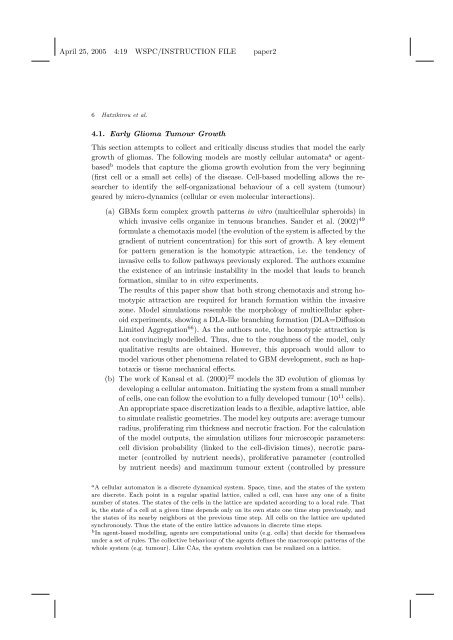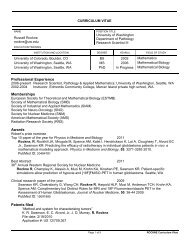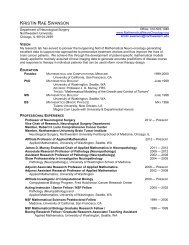April 25, 2005 4:19 WSPC/INSTRUCTION FILE paper2 ...
April 25, 2005 4:19 WSPC/INSTRUCTION FILE paper2 ...
April 25, 2005 4:19 WSPC/INSTRUCTION FILE paper2 ...
Create successful ePaper yourself
Turn your PDF publications into a flip-book with our unique Google optimized e-Paper software.
<strong>April</strong> <strong>25</strong>, <strong>2005</strong> 4:<strong>19</strong> <strong>WSPC</strong>/<strong>INSTRUCTION</strong> <strong>FILE</strong> <strong>paper2</strong><br />
6 Hatzikirou et al.<br />
4.1. Early Glioma Tumour Growth<br />
This section attempts to collect and critically discuss studies that model the early<br />
growth of gliomas. The following models are mostly cellular automata a or agentbased<br />
b models that capture the glioma growth evolution from the very beginning<br />
(first cell or a small set cells) of the disease. Cell-based modelling allows the researcher<br />
to identify the self-organizational behaviour of a cell system (tumour)<br />
geared by micro-dynamics (cellular or even molecular interactions).<br />
(a) GBMs form complex growth patterns in vitro (multicellular spheroids) in<br />
which invasive cells organize in tenuous branches. Sander et al. (2002) 49<br />
formulate a chemotaxis model (the evolution of the system is affected by the<br />
gradient of nutrient concentration) for this sort of growth. A key element<br />
for pattern generation is the homotypic attraction, i.e. the tendency of<br />
invasive cells to follow pathways previously explored. The authors examine<br />
the existence of an intrinsic instability in the model that leads to branch<br />
formation, similar to in vitro experiments.<br />
The results of this paper show that both strong chemotaxis and strong homotypic<br />
attraction are required for branch formation within the invasive<br />
zone. Model simulations resemble the morphology of multicellular spheroid<br />
experiments, showing a DLA-like branching formation (DLA=Diffusion<br />
Limited Aggregation 66 ). As the authors note, the homotypic attraction is<br />
not convincingly modelled. Thus, due to the roughness of the model, only<br />
qualitative results are obtained. However, this approach would allow to<br />
model various other phenomena related to GBM development, such as haptotaxis<br />
or tissue mechanical effects.<br />
(b) The work of Kansal et al. (2000) 22 models the 3D evolution of gliomas by<br />
developing a cellular automaton. Initiating the system from a small number<br />
of cells, one can follow the evolution to a fully developed tumour (10 11 cells).<br />
An appropriate space discretization leads to a flexible, adaptive lattice, able<br />
to simulate realistic geometries. The model key outputs are: average tumour<br />
radius, proliferating rim thickness and necrotic fraction. For the calculation<br />
of the model outputs, the simulation utilizes four microscopic parameters:<br />
cell division probability (linked to the cell-division times), necrotic parameter<br />
(controlled by nutrient needs), proliferative parameter (controlled<br />
by nutrient needs) and maximum tumour extent (controlled by pressure<br />
a A cellular automaton is a discrete dynamical system. Space, time, and the states of the system<br />
are discrete. Each point in a regular spatial lattice, called a cell, can have any one of a finite<br />
number of states. The states of the cells in the lattice are updated according to a local rule. That<br />
is, the state of a cell at a given time depends only on its own state one time step previously, and<br />
the states of its nearby neighbors at the previous time step. All cells on the lattice are updated<br />
synchronously. Thus the state of the entire lattice advances in discrete time steps.<br />
b In agent-based modelling, agents are computational units (e.g. cells) that decide for themselves<br />
under a set of rules. The collective behaviour of the agents defines the macroscopic patterns of the<br />
whole system (e.g. tumour). Like CAs, the system evolution can be realized on a lattice.





